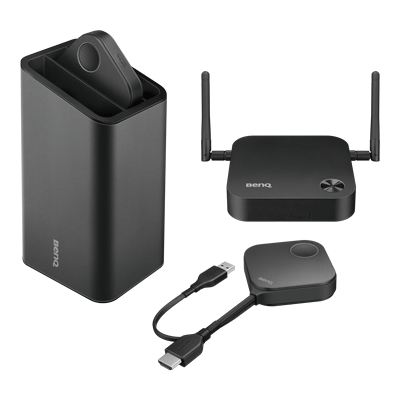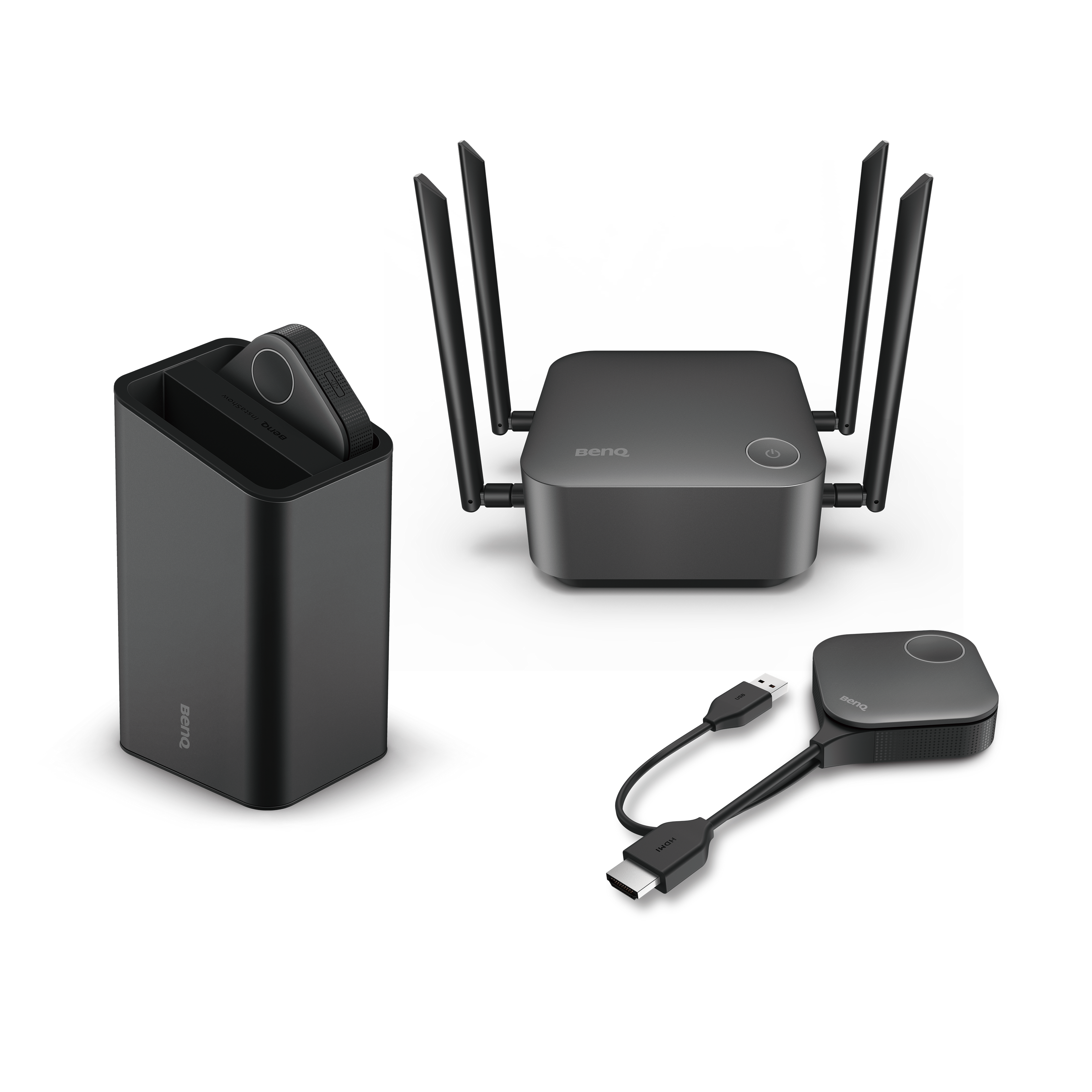Looking for a Mersive Solstice Pod Alternative?
- BenQ
- 2022-10-20
Mersive Solstice is one of the most popular wireless presentation systems designed to leverage corporate network infrastructures by using Wi-Fi to share a display. But with more than 40 alternative solutions on the market, which one could be better for your huddle spaces and collaboration rooms?
The Mersive Solstice Pod of the title is a receiver that attaches to a network and a display, while the proprietary Solstice app runs on the presenter's computer to enable them to connect to the Pod. We will look at popular models sold worldwide that compare with Mersive Solstice offerings at a similar price point and how they stack up on these questions:
Is it easy to set up?
The Mersive Solstice Pod connects to both the network and the display and is designed for use with an organization’s network. Since the Solstice Pod’s live video streaming frame rate is dependent on the host network, there are minimum performance and baseline security standards for smooth video at 30 frames per second. For a typical organizational installation, the network must be configured to open the firewall to half a dozen URLs, and over 30 different network ports. You will also need to consider how much bandwidth is available, as Mersive recommends 50Mbps per receiver to ensure consistent performance, which is one of the highest of all network-based systems.
Mersive recommends you set up an account on their cloud server, followed by nine steps to configure the receiver, including setting up security profiles. Once the network is prepared, apps need to be deployed to the organization and set up on user notebooks. The Mersive app is only available for Windows, Mac, and Android, so if your company uses any Chromebooks, and those must access the system through a browser.
According to Projector Review, “BenQ InstaShow is a great wireless presentation system. Out of the box, it is as simple as you need it to be. You can have it hooked up in moments and be presenting seconds later.” Projector Central pointed out that InstaShow's combination of video quality with ease of setup and use is nothing short of amazing. All BenQ models come with two buttons and a tabletop button holder. The more advanced InstaShow WDC20 and WDC30 work with mobile devices and support up to 4K resolution.
The Barco Clickshare platform uses a button system similar to BenQ InstaShow, but typically requires the Clickshare App to be loaded on the presenter's computer, and requires admin rights to access.
What types of devices are supported?
Mersive Solstice Pod typically requires a proprietary application running on the computer to connect to the receiver. The system only supports Windows and Mac computers, as well as Android and iOS mobile devices. There is no Chromebook support, and while only the more expensive models have wired HDMI input, they do not support HDCP, which is required for most media players, TVs, streaming boxes, and other HDMI devices that play copy-protected media. These sources would need a separate system to connect to the display to share any copy-protected content.
BenQ InstaShow uses standard HDMI or USB-C buttons that work with Windows, Mac, and even Chromebooks. But because it doesn’t require any software and supports HDCP, InstaShow can also connect to hundreds of types of HDMI devices-based such as document cameras, digital media players, and even gaming consoles. For laboratory and engineering work, InstaShow connects to development boards such as Raspberry Pi and industrial equipment that outputs standard HDMI signals, such as spectrum analyzers.
For mobile devices and tablets, InstaShow connects using an HDMI or USB-C button connection, while InstaShow WDC20 and WDC30 also support streaming from mobile devices via Airplay, Miracast, or the InstaShare app loaded on iOS or Android phones and tablets.
Typically, the Clickshare application must be running on the device to connect to the Clickshare receiver. The Clickshare platform offers applications for Windows and Mac OS computers, as well as iOS and Android mobile devices. There is no support for Chromebook or other Linux development boards, such as a Beagle Board. There is also currently no support for devices such as Blu-ray players or document cameras.
Can visitors use them?
For an employee or visitor to access a Solstice Pod, they must log onto the same network that is hosting the Solstice Pod and also have the Solstice app running on their system. For visitors to obtain the app, they will either need to download the app from the Mersive website or log in to the Solstice Pod via the organization’s network. Once connected to the unit, they need to enter their IP address, which then enables them to install the Solstice app on their notebook.
This can present a challenge to certain visitors since many organizations “lock down” their notebooks from running external third-party software to protect from malware and may require IT support and approval for any application to be installed. Also, the Mersive Solstice does not support Chromebooks, so companies and schools that use Chromebooks may need to look for other alternatives.
InstaShow does not require any software applications or network connections for employees and visitors. All is needed is to simply plug in a button and start presenting in seconds. InstaShow is ideal for collaboration rooms, saving both time and money, especially in time-sensitive operations such as law firms. For IT staff, there is no deployment to manage, and visitors with "locked down" computers can connect without having to run extra software or download apps. InstaShow’s industry-standard HDMI and USB-C connections plug into notebooks, mobile phones, and tablets such as iPad Pro and Chromebook.
The Clickshare receiver requires companies to open various network ports in order to work, which may create security flaws. A visitor with a "locked down" computer may not be able to download the ClickShare application onto their devices for security reasons.
Conclusion - which one is right for you?
The subscription-free BenQ InstaShow has become one of the top-selling Mersive Solstice alternatives because it uses simple and intuitive button architecture like Barco Clickshare while eliminating the hassle of downloading applications and having to connect to a local network to present.
For huddle rooms and collaboration workspaces, the plug-and-play approach of InstaShow keeps your meeting focused on topic without having to learn how to use new apps or log in to a protected network. The ability to connect to Chromebooks and other types of devices also makes a significant difference in effective communication using cameras, media players, and even development boards.
| Product | Barco ClickShare C-10 | BenQ InstaShow | Mersive Solstice Pod Gen3 |
Product Connection Type | Barco ClickShare C-10 Button and App | BenQ InstaShow Button Only | Mersive Solstice Pod Gen3 Wi-Fi and App |
Product Security | Barco ClickShare C-10 ISO 27001 AES 128-bit authentication WPA | BenQ InstaShow ISO 27001 AES 128-bit authentication WPA ISO/IEC 15408 EAL6+ certification | Mersive Solstice Pod Gen3 Configurable Encryption |
Product Maximum Number of Presenters | Barco ClickShare C-10 Up to 32 | BenQ InstaShow Up to 64 | Mersive Solstice Pod Gen3 4 |
Product Maximum Resolution | Barco ClickShare C-10 4K 30 fps | BenQ InstaShow WDC10 - 1080p 60fps | Mersive Solstice Pod Gen3 4K 30 fps |
Product Setup and Installation | Barco ClickShare C-10 Middle | BenQ InstaShow Easy | Mersive Solstice Pod Gen3 Network setup and configuration |
Product Employee / Visitor Use | Barco ClickShare C-10 Requires app to run on devices | BenQ InstaShow Plug and play – no software needed | Mersive Solstice Pod Gen3 Requires network login and app to run on devices |
Product Supported Devices | Barco ClickShare C-10 Windows, Mac IOS, Android | BenQ InstaShow Windows, Mac, Chromebooks IOS, Android | Mersive Solstice Pod Gen3 Windows, Mac IOS, Android |
Try InstaShow for FREE Today!
We will contact you as soon as possible to get you set up.
Recommanded Articles
-
Trends & Knowledge
Interested in Purchasing Mersive Solstice Wireless Presentation System?
Try BenQ InstaShow Instead for Wireless Screen Mirroring Insates. No App and Connection to Corporate Network Needed. Learn more about Mersive Solstice vs. BenQ InstaShow.
2022.08.26 -
Trends & Knowledge
Best ClickShare Alternatives for Huddle Rooms
Since its introduction, the Barco ClickShare platform has been one of the most on the market. But now that there are more than 40 competitors on the market, which one is right for your huddle rooms? This article will help you explore your options.
2022.05.13 -
Trends & Knowledge
Is Screen Mirroring Safe?
Using screen-mirroring devices for presenting wirelessly is common, but is it safe and secure? This article addresses the three types of major screen mirroring security risks.
2022.05.13


